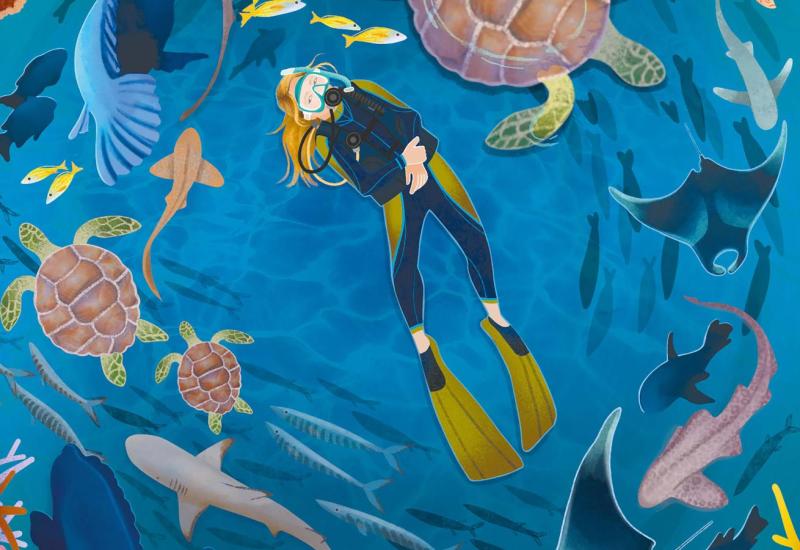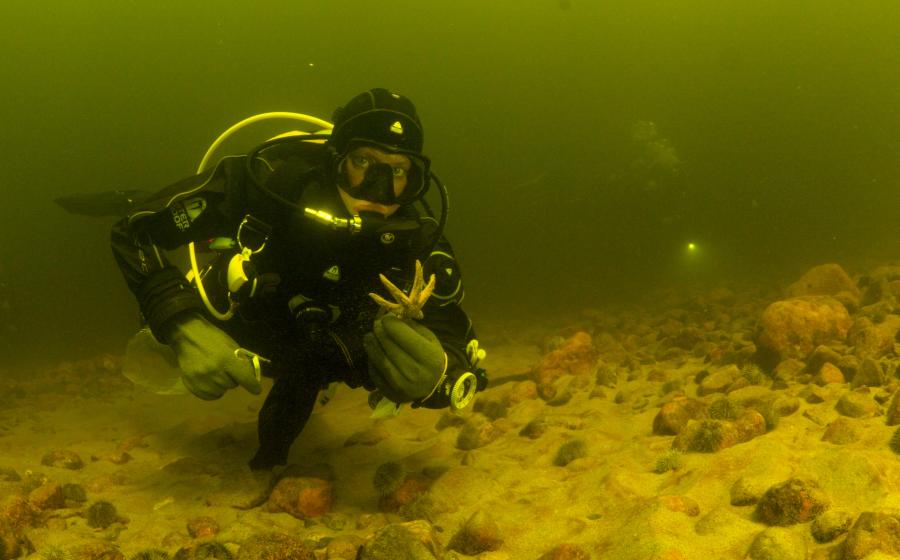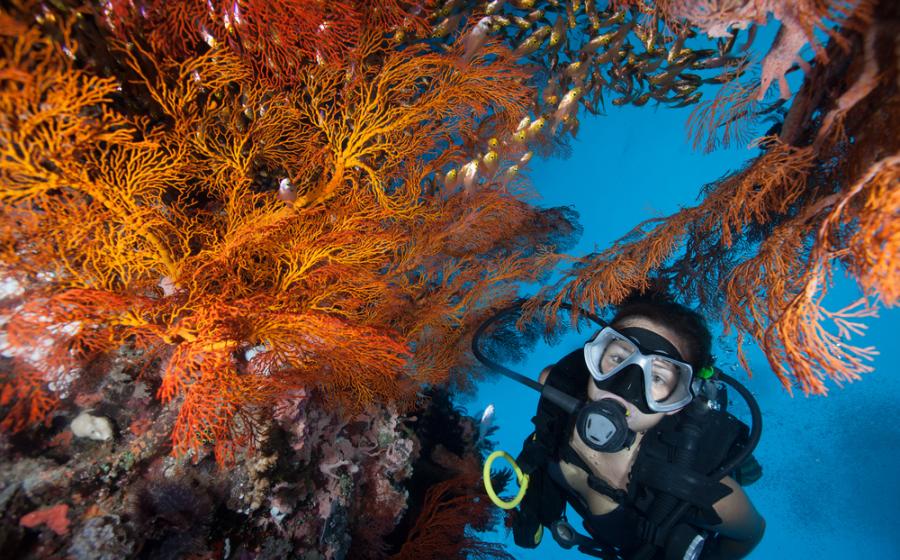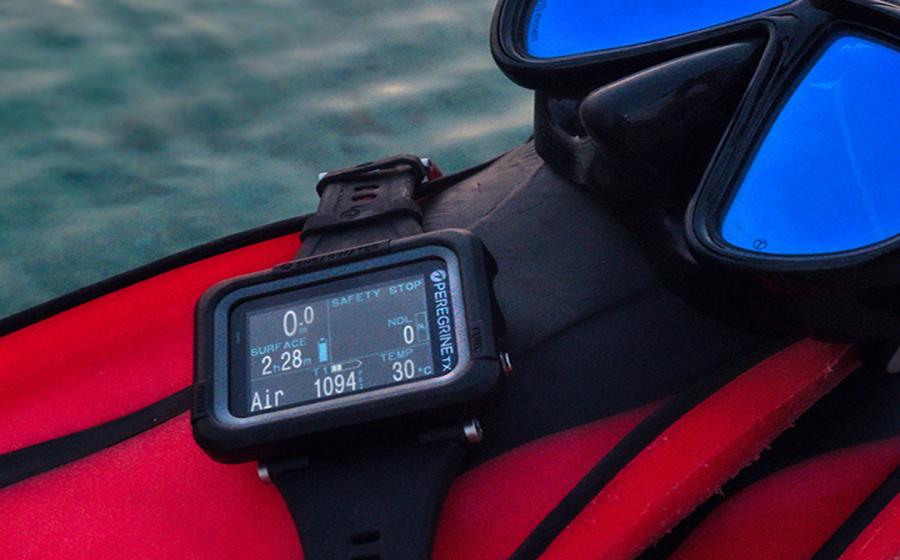Eight Dive Resorts with Great House Reefs
Some divers have an obsession with squeezing the most out of every experience, like using up every last boat dive in your hotel package or aiming to reach the remotest spots possible.
That’s one way to travel.
Here’s another: Take your time and explore the house reef—the one that’s just steps away from the resort’s dive center and staff, and your room.
1. Buddy Dive Resort
Bonaire
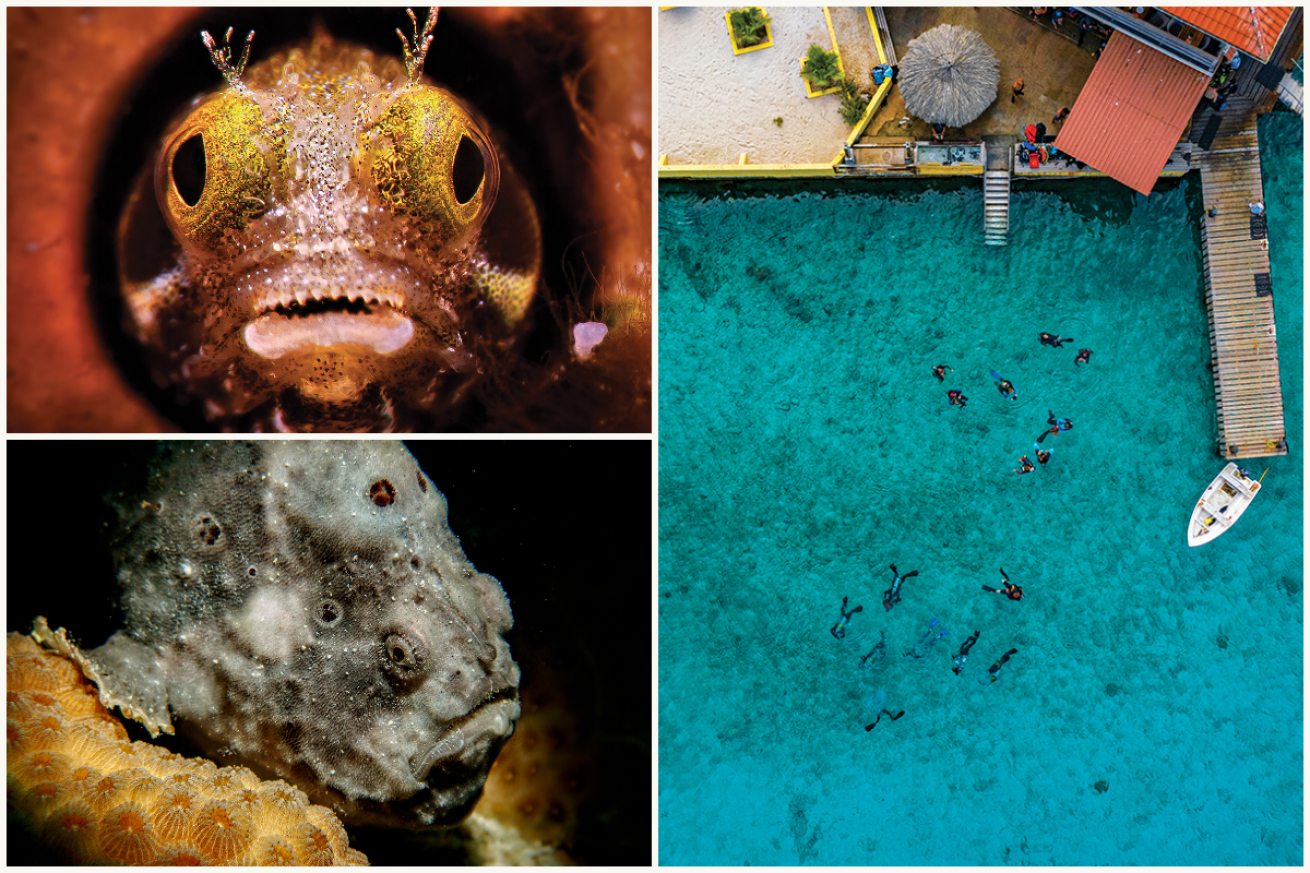
Clockwise from top left: Beth Watson; Lorenzo Mittiga; Caitlin HaleThe house reef at Bonaire's Buddy Dive Resort is a haven for macro treasures such as frogfish and blennies.
In this Dutch Caribbean island famous for a leeward coast packed with 24 miles of shore diving, it would be easy to overlook a house reef like the one at Buddy Dive Resort. But doing so would mean missing out big-time.
“It’s one of the best dive sites they have on Bonaire—so full of life, it’s crazy,” says Augusto Montbrun, dive operations manager at the resort.
In particular, Bonaire is synonymous with macro life, including frogfish and seahorses.
“I tell my guests that I know they are on the house reef every day; you just have to find them.” One of the biggest benefits to a house reef like Buddy’s, with a dive center just a few feet from the water, is that instructors are on the site daily, noting the exact locations of those frogfish, which they share readily with guests.
And it isn’t just frogfish. Take blennies—the two best spots to hunt them are the rubble patches and the hotel’s retaining wall.
Anna DeLoach, self-proclaimed blenny aficionado and co-author of the long-awaited new edition of Reef Fish Behavior, visits the resort yearly to lead a week of presentations focused on marine life.
Says Montbrun, “She jumps in, and she is stuck to that retaining wall because it is full of the blennies that drive her crazy!”
The dive staff also can pinpoint activity among corals. They’ve tracked the spawnings of stony, brain and other corals on their house reef, and can share details with divers who want to coordinate travel to see these epic events.
Add to the list of attractions a depth stretching to 160 feet—ideal for technical diving and training—then consider the big-animal sightings of eagle rays, turtles and 6-foot tarpon, and it’s tough to see why any diver would skip this brimming-with-life gem.
When to Go May to October is the low season, bringing better deals. Coral spawning extends late August to mid-September.
Dive Conditions Water temperatures vary only a little, from 79 degrees F in February and March to 84 in September and October. Visibility is typically between 40 and 100 feet, with at least 60 feet most days.
Website BuddyDive.com
2. Turtle Bay Dive Resort
Cebu, Philippines
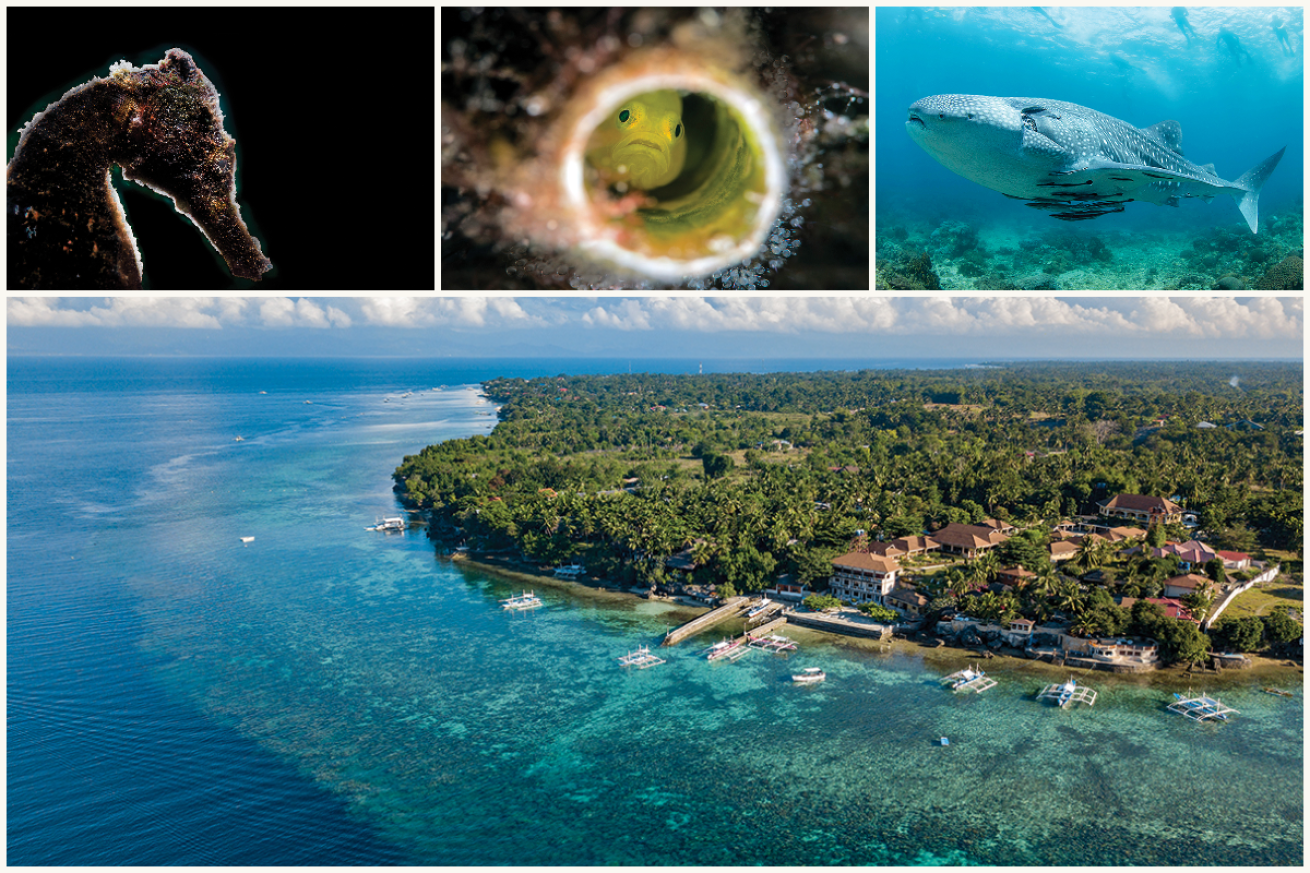
Clockwise from top left: Gerald Nowak (2); David Fleetham; Gerald NowakAnything from tiny macro life to whale sharks—and of course, sea turtles—can be spotted from the house reef at Turtle Bay.
Rare is the resort that offers a wall as its house reef—but thanks to the unique topography of the west side of Cebu Island, Turtle Bay Dive Resort delivers a front-yard dive dropping to 180 feet. Oh, and it has caves.
Like much of Cebu, this house reef, also known as Tongo Point, is known for macro life, including nudibranchs, leaffish, harlequin ghost pipefish, seahorses and crustaceans. A lack of current makes it easy to linger and take it all in.
Of course, the most commonly seen animals are the ones that inspired the resort’s name. “It’s a fact that you can and will see green and hawksbill sea turtles on every dive,” says Clive Jason White, manager of the resort and the dive center.
Beyond the turtles, another house-reef highlight—granted, on a much smaller scale—is the candy crab. Also known as commensal soft coral crabs, these tiny wonders measure less than half an inch. Their legs, striped white and hot pink, help them mimic the colors of the soft corals they perch on top of while feeding on plankton.
Come sunset, divers need only fin a few yards from shore to the shallows to witness the elusive mandarinfish, a gaudy spectacle colored orange, turquoise and electric cobalt. As dusk approaches, this fish edges out to mate, typically from the branches of acropora coral.
Perhaps the most surprising regular at this site is one not commonly seen by shore divers. Whale sharks regularly pass in front of the resort, which sits on the Tañon Strait, separating Cebu from Negros Island.
When to Go The best times to dive are January through May, and the months of November and December.
Dive Conditions Year-round, the water temperatures stay between 81 and 84 degrees F. Visibility is typically 60 feet.
Website TurtleBayDiveResort.com
3. Sunset House
Grand Cayman, Cayman Islands
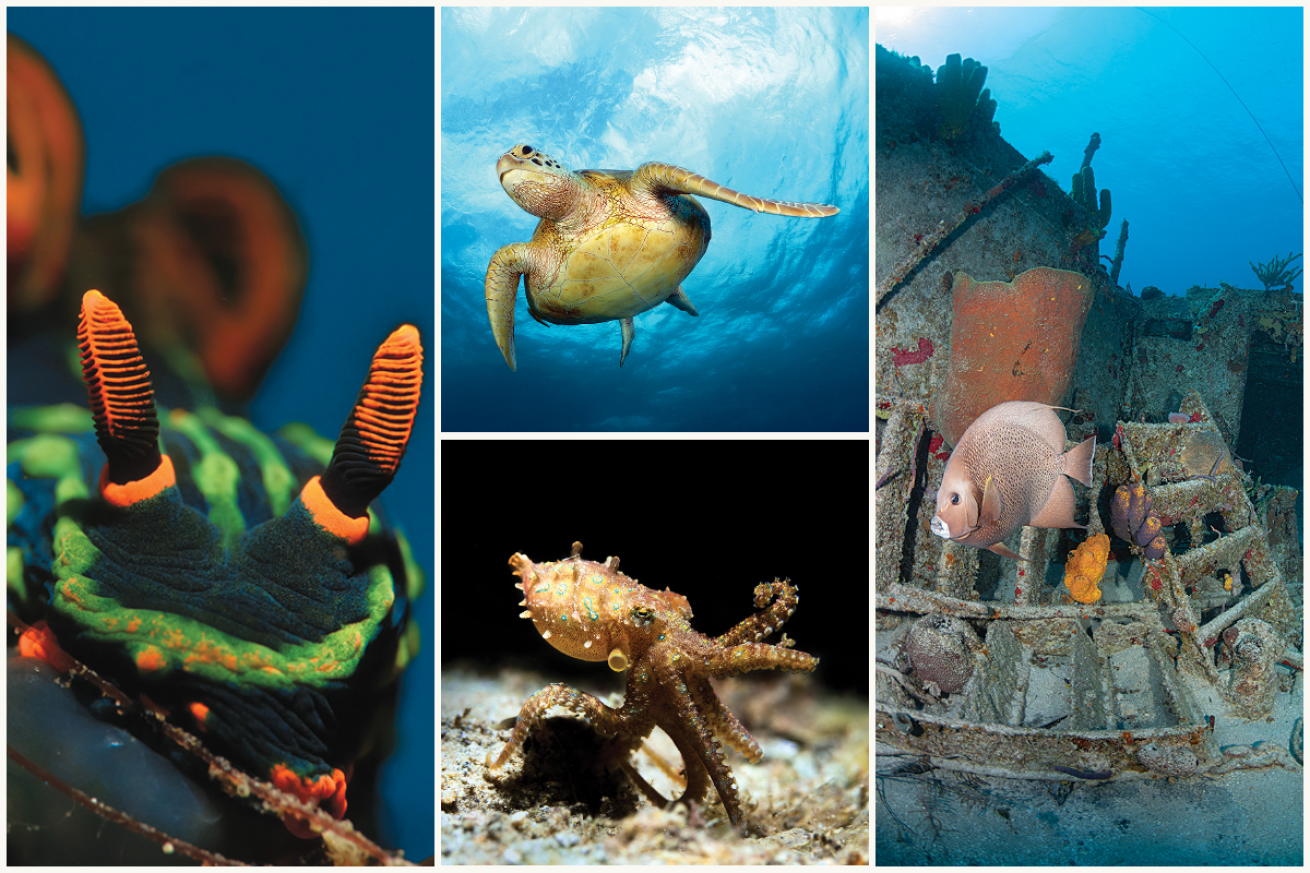
From right: Lureen Ferretti; Gerald Nowak (3)The Sunset House reef dishes diving delights day and night, drawing the average diver in for 15 dives a week.
On any given night, anyone at My Bar, the legendary Grand Cayman watering hole found at the ocean’s edge at Sunset House resort, can tell you when the house reef is going off. “When the lights stop moving, that’s when you know someone has found something really cool,” says Emma-Jane Fisher, one of the managers of the resort.
That something cool is often a Caribbean spiny lobster strolling across the sand, or a slipper lobster crawling over the corals. Of course, octopuses are in the mix.
By day, highlights include the wreck of the David Nicholson, a six-minute swim from shore.
“I always go out there and look for decorator crabs because they’re there—they’re just so well camouflaged,” says Fisher.
The site serves up a bounty of other macro finds, including lettuce sea slugs, sailfin blennies and even seahorses.
If you are hunting macro, be ready to be surprised. “If you’ve got your face buried, you can get startled if you get close to a nurse shark having a sleep or an eagle ray digging in the sand, looking for food,” she says.
With reef, wreck and the famous mermaid statue, the site is enough to easily fill 15 dives a week—the average that most divers do—as well as a week’s worth of evening conversations at the bar.
When to Go For the best deals, travel March through June. Every few years, the island can experience winter storms known as nor’westers December through February, which can affect shore diving on the western coast of the island, where Sunset House is located.
Dive Conditions Winter water temperatures average 81 degrees F, climbing to 84 in summer. Visibility is typically 75 to 100 feet.
Website SunsetHouse.com
4. Matangi Resort
Matangi, Fiji
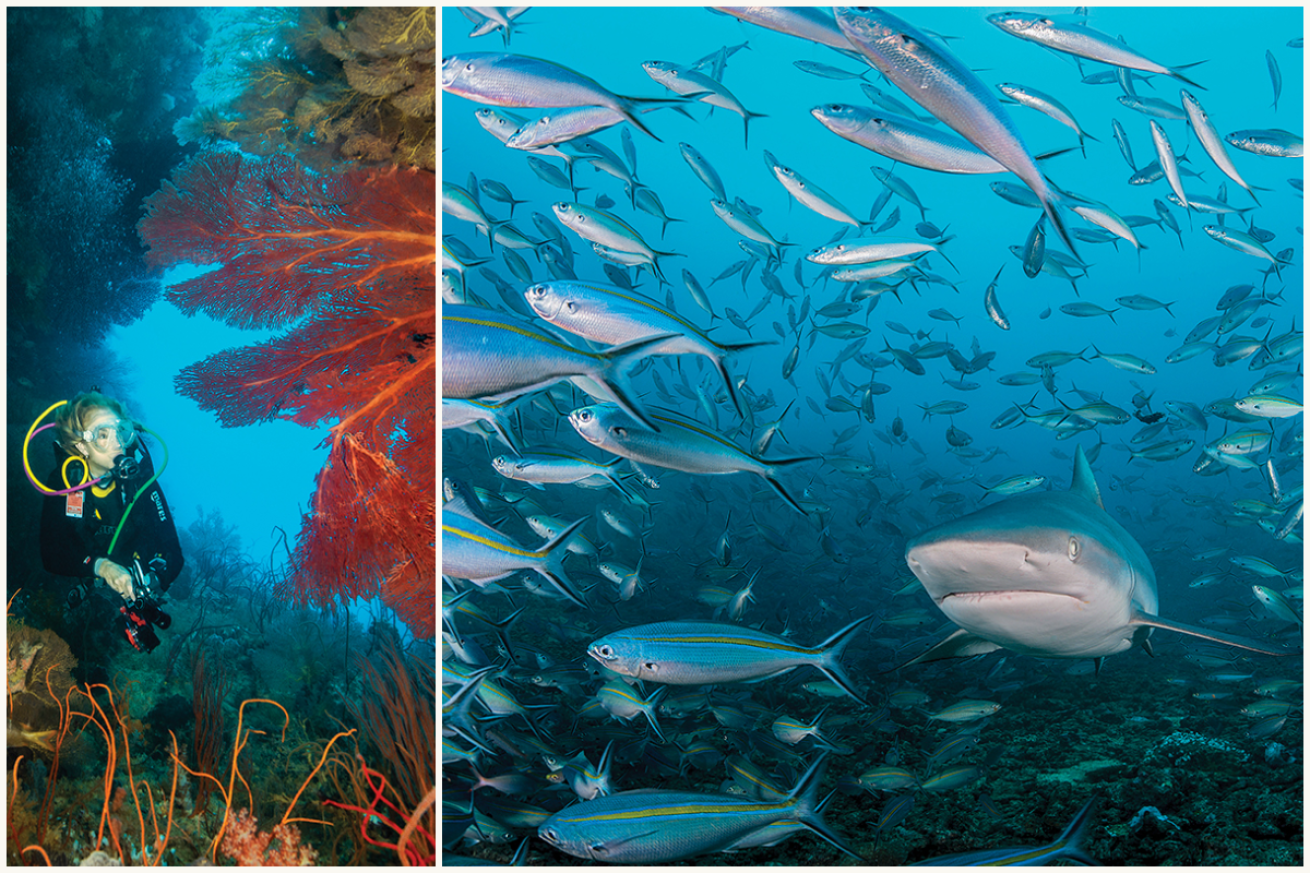
Gerald Nowak (2)Coral forests just steps from the resort offer nearly endless possibilities for animal encounters.
Most people think long boat rides are the only way to reach the forests of soft coral for which Fiji’s islands are famous.
Then again, most people haven’t been to Matangi, a private-island resort northeast of the main island of Viti Levu, next to neighboring Taveuni.
On Matangi, as soon as a diver stands in knee-deep water just yards from the resort dive shop, she can see soft corals—along with tomato clownfish, needlenose butterflyfish and anthias in a palette of outrageous hues.
Granted, says Linda Gutekunst, Matangi dive concierge, “It’s not like going out on our boat to Somosomo Strait with huge dramatic walls.”
Still, the drama is undeniable.
“Anything can come through,” she says. That “anything” has included “a herd of turtles.” Sharks are also common sights. And so are—wait for it—pilot whales.
“It’s getting a lot more common to see the pilot whales right here,” says Gutekunst.
The season for spotting pilot whales extends December to March, Fiji’s summer.
With so much happening just yards from the guests’ bungalows, known in Fiji as bures, perhaps it’s not surprising that some people skip the boat dives altogether.
“We have one client who comes for two weeks every year and just snorkels the house reef all day long. He likes it because he can just walk in and see everything at his leisure.”
When to Go December to March is Fiji’s rainy season, and also the time when cyclones are possible.
Dive Conditions During Fiji’s summer, November to April, water temps are at their highest: 84 degrees F. The rest of the year, water temperatures range from 72 to 77. Visibility can be up to 130 feet; however, during the plankton blooms November to February, it may drop to 50 to 75 feet.
Website MatangiIsland.com
5. CoCo View Resort
Roatan, Honduras
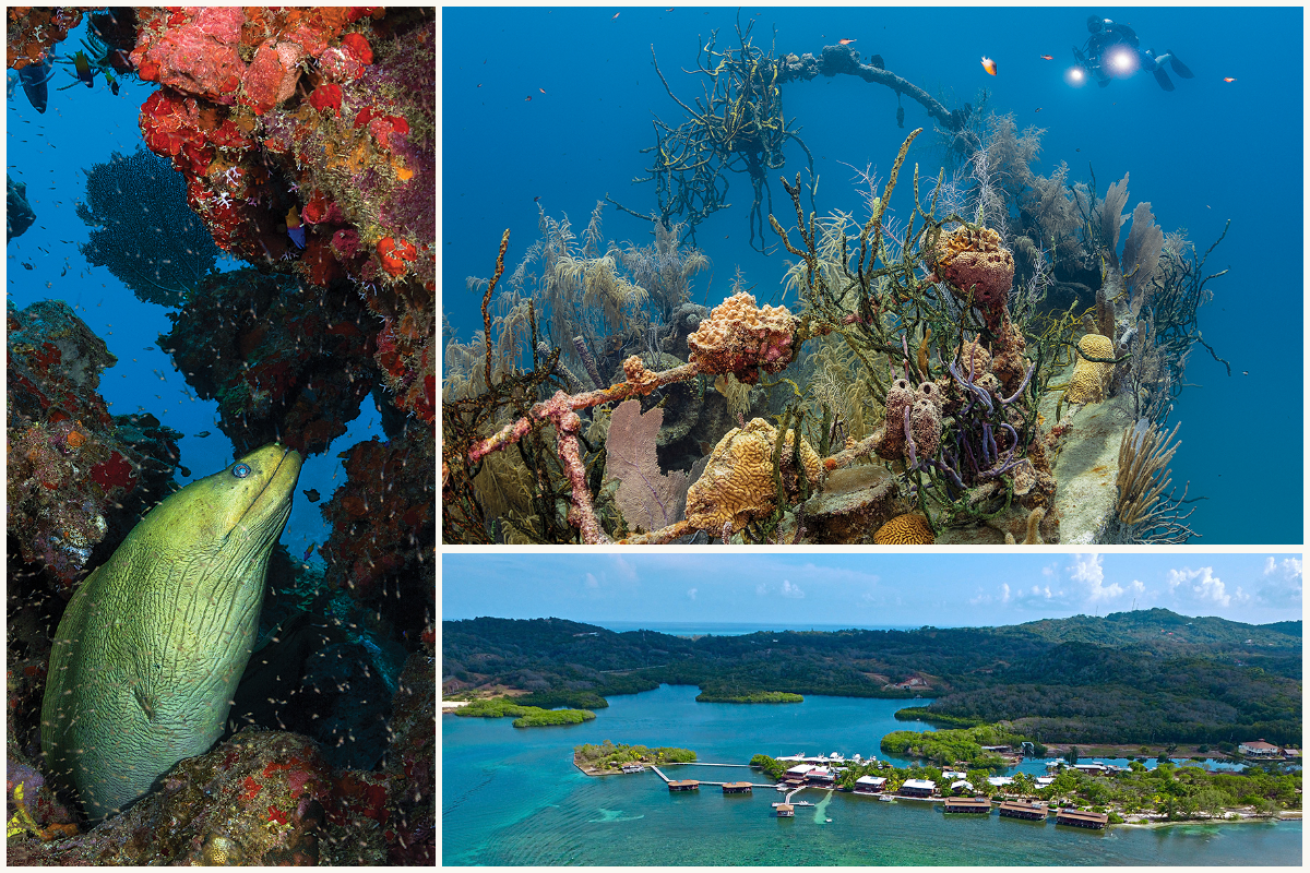
Clockwise from left: Jennifer Penner (2); Tim Blanton ProductionsGuests at CoCo View have instant access to three dive sites, including the Prince Albert from the resort's front yard.
Don’t say “house reef” at CoCo View Resort on the island of Roatan, Honduras. No one will know what you’re talking about.
That’s because the “front yard” of the property widens to include three sites. Swim out, head right and you’re on Newman’s Wall. Go left and hit CoCo View Wall. Head straight and you’re on the wreck of the 140-foot Prince Albert freighter in 40 to 60 feet of water.
The freighter, purpose-sunk more than 30 years ago, has become the foundation for heaps of sponges and corals. Among all the colors it might be a challenge to spot the squid, found almost daily, and in big squadrons.
Not only are there three sites in one spot, but each site is different at different times of the day. “The marine life changes right along with the daily cycle,” says Patty Grier, who owns Dockside Dive Center at CoCo View and has logged more than 5,000 dives in front of the resort. “I’m more likely to find lettuce sea slugs around noon when the sun is directly overhead. They seem to like the warmth. Lobsters tend to be out and about in the mornings, while the crabs seem to prefer the afternoons,” says Grier.
Plus, there’s a bonus site. Many divers overlook the 15 yards of sea grass between the shore and the start of the wall dives—to do so means missing out on a muck-type environment home to banded coral shrimp, flounder, flying gurnards and jawfish with mouths like bowls heaped full of eggs.
When to Go November through January are the rainiest months. March through May brings the most ideal weather.
Dive Conditions From October to March, water temperatures dip to 78 degrees F; from April to September, the average water temp is 82. Visibility averages 100 feet, except during the rainy season, when it can drop to 60 to 80 feet.
Website CoCoViewResort.com
6. Lizard Island Resort
Lizard Island, Australia
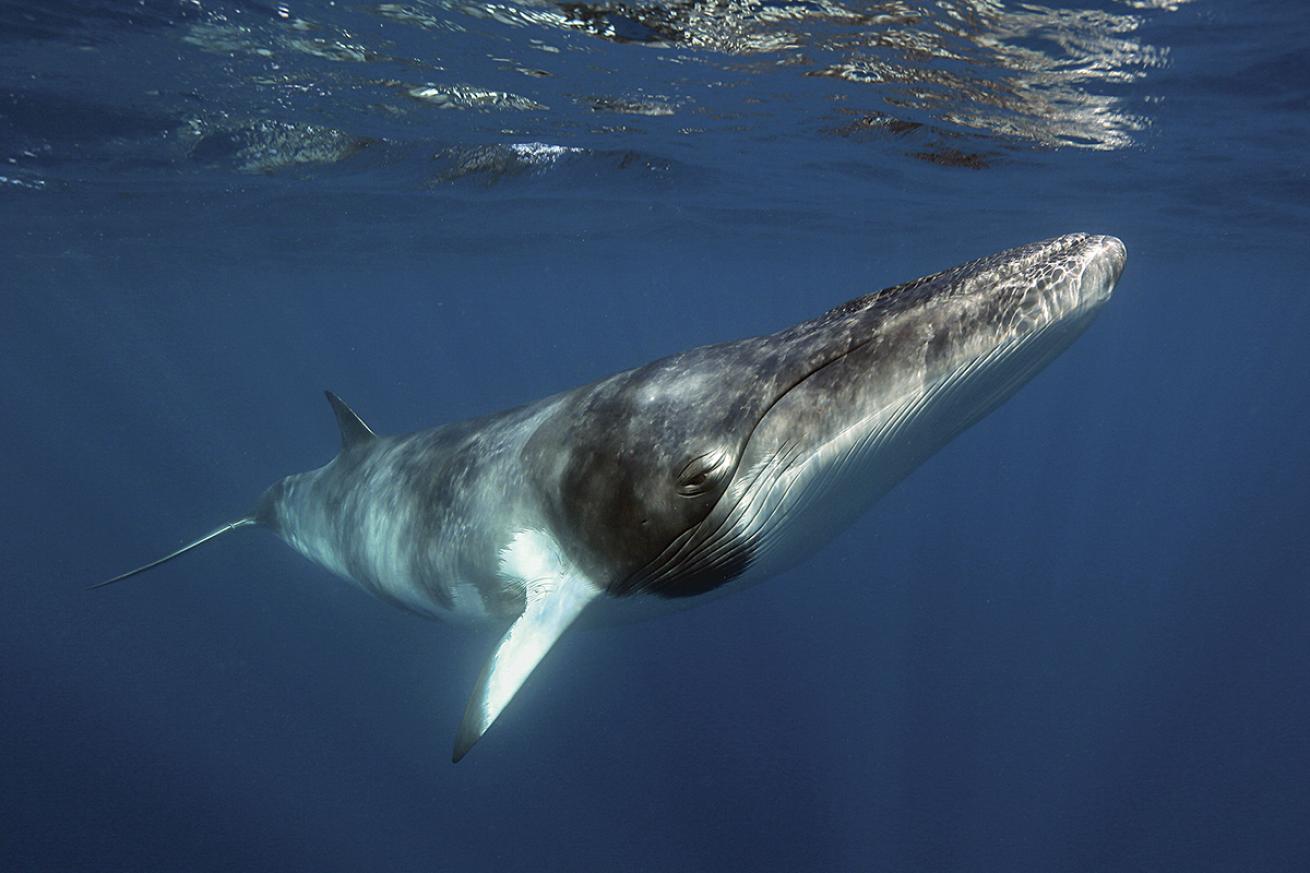
Vanessa MignonMinke whales sail past Lizard Island in June and July.
Several resorts lay claim to the spoils of Australia’s Great Barrier Reef, but Lizard Island holds the distinction of being the northernmost—and most remote—of the bunch.
Nestled on a 2,726-acre national park, this granite island is surrounded by fringing reef and a whole lot of deep water.
This accounts for the minke whales that cruise by every June and July. The drop-off also sees its share of giant manta rays and pods of dolphins.
But it’s not always the big pelagics that are the focus of the marine biologists at the research station down the beach from the resort.
“Tiny fishes with plenty of personality have been described scientifically from specimens found at Lizard Island,” says Dr. Anne Hoggett, director of the Lizard Island Research Station. “There’s the signal goby—found on sand in reef crevices, usually in pairs and doing a spectacular hopping behavior.”
In the same environment, divers can also find the flasher sandgoby, known for repeatedly raising and lowering its dorsal fin, white with bright orange patches.
Overall, the island is home to 1,500 fish species, including larger ones such as the barramundi cod, four species of coral trout and the humphead Maori wrasse. The reefs also contain more than 400 hard coral species.
Then there are the giant clams. Six species are abundant off Lizard Island, including the largest, Tridacna gigas.
Take into account all that biodiversity pooling up in one spot, as well as the feeling of being on a speck of green amid a Coral Sea of blue, and it’s hard to believe that Lizard Island lies just 17 miles from the mainland.
When to Go Mid-August to mid-December sees little rainfall, making for better visibility.
Dive Conditions Summer’s dry weather brings visibility of 150 feet or more. Year-round, water temperatures stay around 80 degrees F.
Website LizardIsland.com.au
7. Scuba Club Cozumel
Cozumel, Mexico
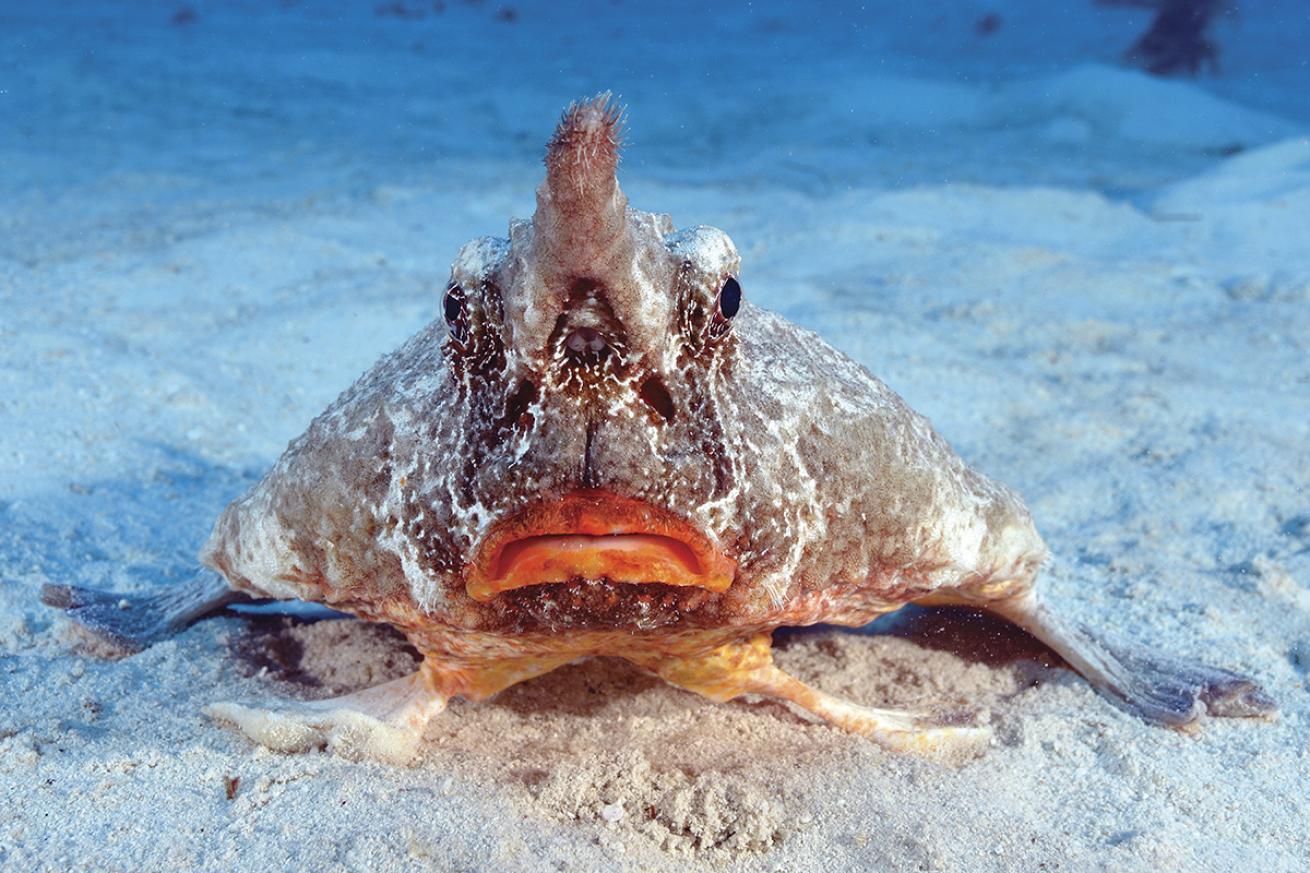
Gerald NowakRed-lipped bat fish await divers in the reefs of Cozumel.
The one thing Cozumel is most famous for is the one thing you won’t get right offshore at Scuba Club Cozumel: current.
The dive-centric property is located in the middle of the west side of the lobster-claw-shaped island, far enough from the southern and northern points that deliver the thrill-ride-like speeds that divers clamor for.
This explains why the house reef is the favorite for some divers. Any diver hunting or focusing on the small stuff wants to avoid anything that’ll knock him out of position. Anything, like, say, a big current.
“For photographers, it is the place where they get the best photos of their trip due to the number of small creatures that are out there and the amount of time they can spend,” says Tim Massimino, owner of the resort.
These repeat guests, along with the staff, know the hotspots for finding seahorses, frogfish, blennies, arrow crabs, stingrays, eels and the occasional barracuda. Come dusk, squids and octopuses join the ranks of what is out and about on the site.
The topography is composed of patch coral heads rather than one continuous coral reef, a contrast that can make critter hunting much more manageable for the novice. The knobby and narrow profile of a seahorse, most often orange or brown, is an easier “get” when you can position yourself to see it against white sand as opposed to the colorful camouflage of sponges and corals.
When to Go Skip the crowds and score the sweetest deals May to September.
Dive Conditions Water temperatures range from 79 in February to 84 at the height of August. Thanks to those epic currents, visibility islandwide is typically 120 feet year-round.
Website ScubaClubCozumel.com
8. Wakatobi Resort
Wakatobi, Indonesia
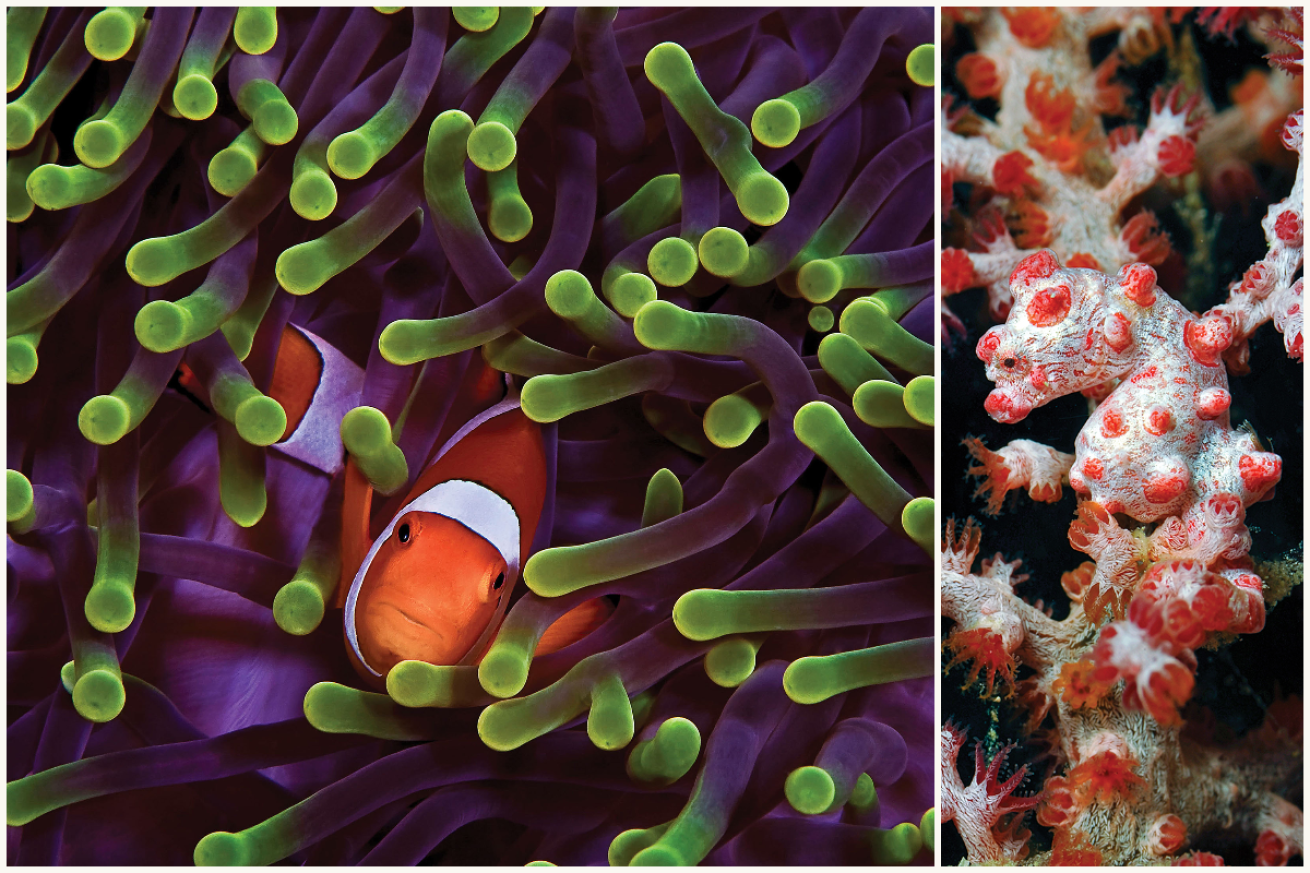
From left: Beth Watson; Gerald NowakBustling life begins in just a foot of water in Wakatobi.
The underwater experience of the house reef at Wakatobi, a private-island resort in Indonesia off Southeast Sulawesi, starts before you even submerge.
“Walk out on the dock and as soon as you’re standing over just a foot of water, you start seeing banded sea kraits and morays,” says Craig Willemsen, owner of Silent World dive center in Bellevue, Washington, and a frequent guest of the resort.
From there, it only gets better: Reach the reef to meet ghost pipefish, orangutan crabs, wonderpus octopuses, mantis shrimps and more—with an emphasis on more. On the house reef alone, there are several species of pygmy seahorses.
And that’s just one ecosystem. “In the shallows, you have one type of coral, and then you drop to 40 feet, and it’s a completely different ecosystem,” says Willemsen. “There’s no other way to describe it than ‘sensory overload.’”
When to Go March through December brings the driest, most favorable conditions.
Dive Conditions Water temperatures range from 77 degrees F in August to 86 in October. Visibility ranges from 60 to 120 feet.
Website Wakatobi.com
Related



